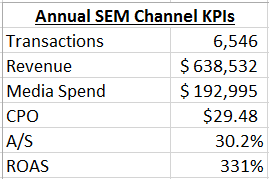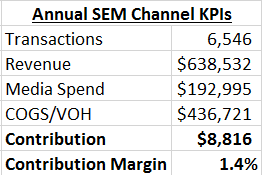Is Your Agency “Profit-Driven”?
It’s a pet peeve of mine when an agency throws the term “profit” around loosely. Many agencies rave about how profitable their services are for their clients, yet make little to no attempt to measure or report on how much profit their services yield for the client. But what makes an agency profit-driven and how do you identify an honest paid search agency?
Don’t have time to read the blog? Check out this quick video:
Many other agencies report on KPIs that are either solely efficiency or volume-based, including:
These metrics alone are flawed because they don’t account for business expenses outside channel-related costs like media spend. If you have no cost of goods, no variable overhead expenses, no returns, no pick/pack/ship costs, and no credit processing fees, then maybe relying solely on these metrics is fine for you.
However, if your business incurs any of the above, you should instead account for these expenses when managing your SEM channel. (Read more about using profit as your core KPI.)
If Your Agency Doesn’t Measure Profit, They Cannot Maximize Profit
Which raises the question: if your agency isn’t actively measuring and reporting on profit, how can you expect to maximize profit while working with them? Here’s an example of why profit-driven management is so important. This retailers’ agency is currently reporting on either efficiency or sales metrics. Here are their annual SEM KPIs.

This agency has been told that they need to maintain an average CPO no greater than $30. While not reported above, this agency has also driven a 100% increase in SEM revenue this year vs last, while managing to come in under the CPO target which the retailer set for them. These are great results which the agency should be proud of, right?
Let’s factor in COGS and VOH expenses now.

COGS and VOH expenses total ~68.4% of revenue, which changes the picture quite a bit. Following the approach of optimizing for efficiency and volume targets, this agency managed to drive $8,816 in contribution on $638,532 in revenue, or a 1.4% contribution margin. That’s not necessarily great, but at least the retailer didn’t take a loss on the channel this year, right?
Who Benefits the Most in Your Client-Agency Relationship?
Now let’s factor in the cost of the agency and return rate.

Ouch – this retailer actually lost $30,171 on their SEM channel this year.
Even without accounting for the return rate, this retailer still posted a loss on the channel. In this relationship, the only ones who made a profit were the ad network and the agency, while the retailer has been hung out to dry.
In this example, the value of the work which the agency produced for this business was not sufficient to cover their own cost. Will this retailer make up for these losses through the LTV of the new customers which were acquired this year? Perhaps – but the current agency isn’t measuring that either.
Conclusion
Who benefits the most in your client-agency relationship? Is it you, the retailer? Or does the agency walk away the winner? If profit is not being measured, it cannot be maximized. If your agency tells you profit is being maximized, ask them how they can be so sure. Ask them to prove it to you. Force your agency to measure profit. Force them to be transparent.
Want to learn more about profit as a KPI? Check our our Shopify Integration to learn how we make it easy to get a holistic view of your customer and marketing campaign performance data.
Or if you’re ready to make the switch to a profit-driven agency, speak to one of our analysts today!








